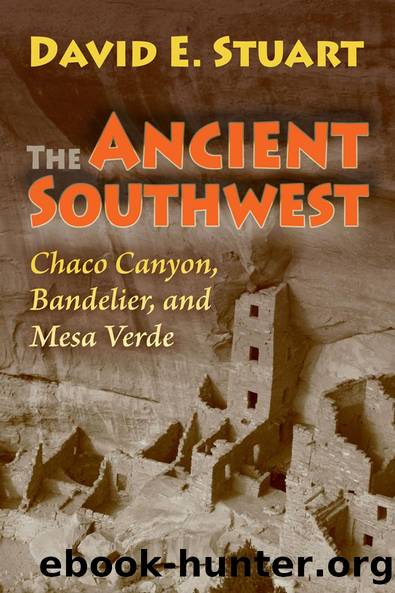The Ancient Southwest by David E. Stuart

Author:David E. Stuart [Stuart, David E.]
Language: eng
Format: epub
Tags: Social Science, Archaeology
ISBN: 9780826346391
Google: __KNg6yj10MC
Publisher: UNM Press
Published: 2010-02-25T05:34:52+00:00
*Bat Cave was reexcavated in the 1980s by professor W. H. Wills of the University of New Mexico. Read about those important findings and reinterpretations in Early Prehistoric Agriculture in the American Southwest, School of American Research Press, 1989, Santa Fe.
Chapter 12
GILA WILDERNESS
Home of New Mexicoâs First Prehistoric Villages
The first snows have already fallen in southwestern New Mexicoâs vast, forested Gila Wilderness. A brilliant November sun warms resin-coated evergreens, adding pine scent to crystalline mountain air while melted snow cascades to the ground. Thousands of people are drawn to this rugged sprawling country each yearâmost to enjoy the beauty and isolation of nature âunspoiledâ by human endeavor. Few, however, realize that among these canyons, piñon groves, and clear, icy streams, New Mexicoâs first prehistoric villages were created. About sixteen hundred years ago, todayâs âwildernessâ was the most densely inhabited region in the state.
It was around A.D. 250 when prehistoric Mogollon people began to consistently build small pithouse villages in the ponderosa-fringed upland meadows of west-central New Mexico. Nearly half a century ago the Tularosa and Cordova cave sites were excavated in Catron Countyâs Pine Lawn district. Although not genuine village sites, these dry caves yielded a well-preserved record of the transition to early agricultural villages. Dozens of textbooks commemorate these finds by designating the first Mogollon villages as the Pine Lawn or Hilltop Phase. Over the years many pithouse sites have been found along the San Francisco River and adjacent forest areas. Here New Mexicoâs first pottery was madeâa simple brownware named after the contemporary village of Alma.
These villages typically consisted of five to twenty shallow, timber-roofed dugouts, or pithouses. House shape, depth, and size varied. Some were round, others squared, and many were shaped like a pinto bean. Some pithouses had central fire hearths, while others had none. Archaeologists disagree on the meaning of specific variations but accept the idea that village life was still in an experimental stage. Even the basic economy varied from site to site and from one locale to another.
Download
This site does not store any files on its server. We only index and link to content provided by other sites. Please contact the content providers to delete copyright contents if any and email us, we'll remove relevant links or contents immediately.
Born to Run: by Christopher McDougall(7066)
The Leavers by Lisa Ko(6913)
iGen by Jean M. Twenge(5368)
Sapiens by Yuval Noah Harari(5297)
The Kite Runner by Khaled Hosseini(5088)
Spare by Prince Harry The Duke of Sussex(5078)
Machine Learning at Scale with H2O by Gregory Keys | David Whiting(4199)
Bullshit Jobs by David Graeber(4101)
Never by Ken Follett(3800)
Goodbye Paradise(3730)
Livewired by David Eagleman(3687)
Fairy Tale by Stephen King(3227)
A Dictionary of Sociology by Unknown(3032)
Harry Potter 4 - Harry Potter and The Goblet of Fire by J.K.Rowling(2996)
The Social Psychology of Inequality by Unknown(2941)
The Club by A.L. Brooks(2864)
Will by Will Smith(2795)
0041152001443424520 .pdf by Unknown(2787)
People of the Earth: An Introduction to World Prehistory by Dr. Brian Fagan & Nadia Durrani(2702)
